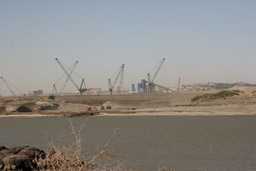FutureDAMS
Thousands of large dams are currently planned or under construction around the world. How can we ensure we maximise their benefits while minimising the negative impacts?

The Cahora Bassa dam in Mozambique is the largest hydroelectric power plant in southern Africa, but there is concern about its impacts on downstream agriculture and communities (Rich Beilfuss/International Rivers via Flickr, CC BY-NC-SA 2.0)
A new generation of dam schemes are being built to meet growing demands for energy and irrigation, with the potential to make a significant contribution towards achieving the Sustainable Development Goals and climate change commitments under the Paris Agreement.
However, these projects also have a downside. Millions of people have already been displaced by reservoir construction around the world, prompting questions about the uneven distribution of costs and benefits of large dams.
IIED is a key partner in the FutureDAMS research project, led by the University of Manchester, which is working to improve the design, selection and operation of dams to support sustainable development.
What is IIED doing?
IIED senior associate Jamie Skinner is the capacity building director of FutureDAMS, and sits on its strategic management team. The institute is mainly involved in two areas of research work:
- Social impacts of large dams: understanding good resettlement approaches – how the post-project benefit sharing streams from dams can promote local development within (such as gender) and between vulnerable populations (such as upstream-downstream).
The project will also determine how impacts of dams on local populations (on community cohesion, livelihoods, asset tenure, and gender equality, for example) can best be addressed within practical operational frameworks to ensure more equitable distribution of benefits. Key to this are the conditionalities imposed by the dam financiers (such as China and the Climate Bonds Initiative), and work includes understanding and influencing their policies
- Climate finance: examining the decision making around pathways to low-carbon and climate-resilient development alongside insights on energy and water investments.
The sustainability of infrastructure projects requires resilience to political imperatives, acceptability across the breadth of stakeholders and alignment with existing and probable future environmental commitments. These in turn influence the finance institutions’ understanding of the risk of different types of investment, including hydropower, and their decisions on both future investment choices and risk transfer (such as insurance).
This positioning can then affect both investment opportunities to build ambition for the Conference of the Parties (COP26) of the UNFCCC in Glasgow in 2020, update National Determined Contributions and deliver the US$100 billion of climate finance promised.
Activities include:
- A literature review of published scientific articles about the resettlement of people displaced by reservoir construction. This has identified gaps in the literature, such as how to achieve ‘good’ resettlement
- A roundtable meeting looking at the future of private sector investments in sustainable hydropower. Hydropower has great pootential as a low-carbon source of energy, but carries financial, social and environmental risks
- A policy brief reviewing climate finance policies for hydropower, accompanied by a detailed issue paper, and
- A review of drivers underlying China’s approach to managing the environmental and social impacts of infrastructure financed or delivered overseas by Chinese banks and companies.
News and updates
Publications
Partners
Global Development Institute, University of Manchester
Institute of African Studies, University of Ghana
Council for Scientific and Industrial Research, Ghana
International Union for Conservation of Nature, Switzerland
International Water Management Institute, Sri Lanka
Methods for Irrigation and Agriculture, Jordan
Yangon Technological University (YTU), Myanmar
Centre for Ecology and Hydrology
Department of Geography, University of Cambridge
Cambridge Institute for Sustainability Leadership, University of Cambridge
Department of Civil, Environmental & Geomatic Engineering, University College London
Institute for Sustainable Resources, University College London
Department of Statistical Sciences, University College London
School of Civil Engineering and Geosciences, Newcastle University
Department of Geography and Environmental Science, University of Southampton
Centre for Research in Social Simulation (CRESS), University of Surrey









